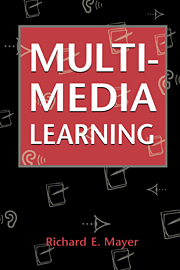Book contents
- Frontmatter
- Contents
- PREFACE
- 1 The Promise of Multimedia Learning
- 2 Multimedia Instructional Messages
- 3 A Cognitive Theory of Multimedia Learning
- 4 Multimedia Principle
- 5 Spatial Contiguity Principle
- 6 Temporal Contiguity Principle
- 7 Coherence Principle
- 8 Modality Principle
- 9 Redundancy Principle
- 10 Individual Differences Principle
- 11 Principles of Multimedia Design
- REFERENCES
- AUTHOR INDEX
- SUBJECT INDEX
2 - Multimedia Instructional Messages
- Frontmatter
- Contents
- PREFACE
- 1 The Promise of Multimedia Learning
- 2 Multimedia Instructional Messages
- 3 A Cognitive Theory of Multimedia Learning
- 4 Multimedia Principle
- 5 Spatial Contiguity Principle
- 6 Temporal Contiguity Principle
- 7 Coherence Principle
- 8 Modality Principle
- 9 Redundancy Principle
- 10 Individual Differences Principle
- 11 Principles of Multimedia Design
- REFERENCES
- AUTHOR INDEX
- SUBJECT INDEX
Summary
A multimedia instructional message is a communication using words and pictures that is intended to promote learning. For example, a multimedia instructional message in a book could include printed text and illustrations, whereas a multimedia instructional message on a computer could include narration and animation. Examples of multimedia instructional messages include words and pictures intended to explain how lightning storms develop, how car braking systems work, and how bicycle tire pumps work.
WHAT ARE MULTIMEDIA INSTRUCTIONAL MESSAGES?
This book is concerned with the design of multimedia instructional messages. A multimedia instructional message is a communication using words and pictures that is intended to promote learning. This definition has three parts: First, the message part of the term reflects the idea that multimedia instructional messages are communications or presentations involving a teacher and learner. Second, the instructional part of the definition reflects the idea that the purpose of the multimedia instructional message is to promote learning (including understanding) in the learner. Third, the multimedia part of the definition reflects the idea that the multimedia instructional message is presented using both words and pictures.
In this chapter, I present three main examples of multimedia instructional messages: an explanation of how lightning storms develop, an explanation of how car braking systems work, and an explanation of how bicycle tire pumps work. For each example, I present the explanation in words to show the conventional way the material is presented as a single-media instructional message.
- Type
- Chapter
- Information
- Multimedia Learning , pp. 21 - 40Publisher: Cambridge University PressPrint publication year: 2001



